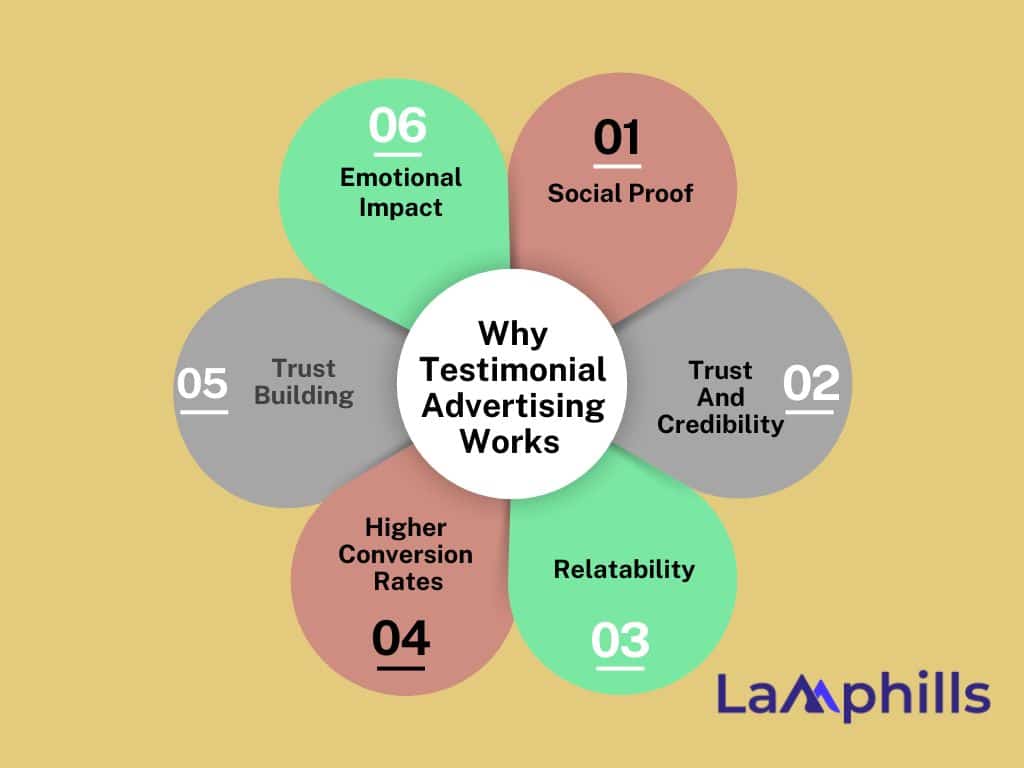I was once stuck trying to choose between iPhone and Samsung products. I researched, and compared products, but wasn’t satisfied until I watched a few videos of people who use these products. Their confirmation was all I needed to make my purchase, that’s the power of testimonial advertising.
Brands no longer sell products or services alone; they sell trust and customer testimonials are one of the ways of building that trust. Testimonials are often seen as raw and unfiltered reflections of real customer experiences. When correctly done, testimonial advertising can transform a curious visitor into a lifelong customer.
This article dives deep into how brands use real customer stories to skyrocket their marketing efforts and win over hearts. Stick around to discover actionable strategies, relatable examples, and the emotional power of leveraging testimonials in today’s marketing world.
Key Points
- Brands no longer sell products or services alone; they sell trust and customer testimonials are one of the ways of building that trust.
- Testimonial advertising uses customer success stories to promote your brand, product, or service. It leverages the voices of satisfied customers to highlight how your solution has made a difference in their lives.
- According to Nielsen, 92% of consumers trust recommendations from peers or people they know over any form of advertising.
- If your testimonial advertising will be successful, you must avoid outdated testimony, using fake testimonies, or neglecting diversity.
What Is Testimonial Advertising?
Testimonial advertising is all about showcasing customer success stories to promote your brand, product, or service. It leverages the voices of satisfied customers to highlight how your solution has made a difference in their lives. Whether through videos, written reviews, or social media shoutouts, testimonials are the social proof potential buyers seek to validate their decisions.
According to Shopify, testimonials are the modern word-of-mouth, amplified by the digital space. Nielsen also said that 92% of consumers trust recommendations from peers or people they know over any form of advertising. It’s like hearing your best friend rave about that new coffee machine or smartphone.
Why Testimonial Advertising Works

The reason testimonial advertising is so effective can be summed up in one word: emotion. Cardi B hair regime gained traction years ago because she took to the internet to share her hair journey. People who suffered hair loss after childbirth or anyone who wants healthier hair tried out that hair routine. Here’s the deal, people connect with stories, and testimonials are real-life stories told by everyday customers. They don’t just outline the benefits of a product; they tell you how the product made someone’s life easier, better, or more joyful. The following are some of the reasons why testimonials work:
#1. Social Proof
Humans naturally look to others for guidance, especially when making decisions. Seeing others succeed with your product is reassurance for new customers. A recent report found that 84% of people trust online reviews as much as personal recommendations from friends or family.
#2. Trust and Credibility
No one wants to feel like they’re being “sold to.” Testimonial advertising helps take the spotlight off your company’s marketing efforts and put it on real users. The honesty and authenticity of a customer’s voice resonates most.
#3. Relatability
When potential customers see someone share similar struggles and desires, it becomes easier for them to picture themselves achieving the same success. Therefore, testimonial advertising is your chance to tap into that relatability.
Take the skincare brand Glossier, for instance. Their marketing relies heavily on customer testimonials, often sharing unfiltered, user-generated content on social media. This approach fosters authenticity that turns casual users into brand advocates.
#4. Higher Conversion Rates
Testimonial ads have been shown to boost conversion rates. For example, featuring testimonials on a landing page can increase conversion rates by up to 34%.
#5. Trust Building
Testimonial advertising lend credibility to a brand, especially if they feature real, relatable individuals. They reduce skepticism and help prospects feel more confident in their purchasing decisions.
#6. Emotional Impact
Stories shared in testimonials create a deeper emotional connection with the audience, making the product more memorable.
Types of Testimonial Advertising Brands Can Use
Now, let’s break down some of the most effective forms of testimonial advertising you can leverage below:
#1. Video Testimonials
Video testimonials have become one of the most powerful forms of advertising. When you can see and hear a real customer explaining how your product has changed their life, it creates an emotional bond. A Wyzowl study shows that 84% of people have been convinced to purchase after watching a brand’s video. This is a perfect format for telling visually engaging and highly persuasive stories.
#2. Social Media Testimonials
Platforms like Instagram, TikTok, and Twitter are treasure troves of user-generated content (UGC). Every time a happy customer tags your brand in their post, story, or video, that’s a testimonial! With 79% of people saying that UGC highly impacts their purchasing decisions, social proof on social media platforms can be a game-changer. For example, Gymshark regularly re-shares customer transformation stories and workout videos, which serve as testimonials for the quality of their fitness gear.
#3. Customer Quotes and Case Studies
Written testimonials, especially those that include detailed results, add credibility. Think of this format as a mini success story—something that provides potential buyers with clear, measurable results. B2B brands often rely on case studies, where they show how their product helped a client achieve tangible success, such as “Increased sales by 25% in just six months” or “Reduced customer service response time by 40%“.
How to Do Testimonial Advertising Right: Best Practice
To maximize the effectiveness of testimonial advertising, it must be done correctly. The following are some tips for crafting testimonial ads that convert:
#1. Prioritize Authenticity
Customers can spot fake or overly polished testimonials a mile away. So, keep it real. Encourage genuine feedback, even if it’s not perfect. Authenticity fosters trust, and trust leads to conversions.
#2. Highlight Diversity
Showcasing diverse testimonials—from various customer demographics, industries, or regions—ensures that more potential buyers can see themselves using your product. The more diverse the range of stories, the broader your appeal.
#3. Include Measurable Results
Numbers speak volumes. If your product or service has helped a customer achieve concrete results, share those. It’s more persuasive to say, “Our software increased productivity by 30% in one quarter” than simply, “This software is great!”
#4. Make It Visual
If possible, use images or videos to enhance your testimonials. A happy face or a successful outcome makes the testimonial feel more relatable and human.
#5. Showcase Measurable Results
The best testimonials are those that provide concrete, measurable results. Instead of vague praise like “This product is great,” focus on specific outcomes like “After using this service, my sales grew by 15% in two months.”
#6. Leverage User-Generated Content (UGC)
Encourage your customers to create testimonials by sharing their stories on social media. User-generated content builds trust and also helps extend the reach of your testimonial advertising campaign.
How to Ask Customers for Testimonials
Getting great testimonials requires a thoughtful approach. Below are some of the ways I encourage customers to share their experiences:
#1. Identify Happy or Satisfied Customers
Reach out to satisfied customers who have expressed their appreciation through emails, social media, or reviews.
#2. Make It Easy
Provide customers with a testimonial template or ask simple, direct questions that guide them in sharing their experience.
#3. Offer Incentives
Encourage customers to leave testimonials by offering them incentives such as discounts, special offers, or exclusive content.
#4. Follow-Up Emails
After a successful transaction, send a personalized follow-up email asking for feedback and permission to use their testimonial in your marketing.
Examples of Testimonial Advertising
Let’s take a look at some brands that have successfully used testimonial advertising to build credibility, connect with their audience emotionally, and ultimately, drive more sales.
#1. Slack’s “Customer Love” Campaign
Slack, the popular workplace communication tool, ran a “customer love” campaign showcasing testimonials from real users. Instead of focusing solely on big businesses, they highlighted how different-sized companies and nonprofit organizations use Slack to enhance collaboration. Each testimonial video or written piece had a unique voice, showing how Slack solved specific pain points for each user. The focus was entirely on the user experience, putting the customer’s voice at the forefront.
#2. Amazon
Amazon’s use of customer reviews is perhaps one of the best-known forms of testimonial advertising. These written testimonials help millions of customers make informed decisions daily. 95% of people read reviews before purchasing, showing how critical customer feedback is to e-commerce success.
#3. Nike’s “Unlimited You” Campaign
Nike has long been known for its empowering marketing campaigns. In their “Unlimited You” campaign, Nike featured real stories of everyday athletes pushing beyond their limits. These testimonials highlighted their personal triumphs and determination, showcasing Nike gear as a subtle part of their journey. The emotional connection with viewers helped Nike reinforce its message that their products are designed for people of all levels, not just professionals. The testimonials came from real people, sharing authentic stories of perseverance.
#4. Dropbox for Business Case Studies
Dropbox for Business creates in-depth case studies featuring real companies and how they’ve benefited from using Dropbox’s services. These case studies are formatted like testimonials, where the company describes its initial problem and how Dropbox provided the perfect solution. They include measurable results such as improved collaboration, time saved, or increased productivity. Each testimonial include clear, and measurable outcomes, showing how Dropbox made a tangible difference.
#5. Warby Parker’s Customer Reviews
Warby Parker, the popular eyeglass retailer, integrates customer reviews and testimonials into its product pages and social media. The company uses real customer stories, often accompanied by before-and-after images of users wearing Warby Parker glasses. Many testimonials highlight their easy and affordable at-home try-on service, making the purchasing process feel personal and risk-free. They use visual testimony showing photos of customers with their new glasses, and also re-shared customers’ posts from Instagram, showcasing real, unedited feedback.
#6. Glossier’s Customer-Centric Social Media Strategy
Glossier, a beauty brand, has built its success on user-generated content and customer testimonials. Their Instagram is filled with customers sharing their experiences with Glossier products. The brand frequently reposts these stories, often unfiltered, from everyday users, emphasizing that Glossier products are for everyone. Testimonials come in the form of Instagram comments, product reviews, and even YouTube videos. Glossier’s approach felt personal because they often shared raw, unedited customer testimonials and community building.
Lamphills Testimonial Campaign Planning Template
This Lamphills campaign planning template can help you plan and organize a full testimonial advertising campaign as a small business owner or a marketer.
Lamphills Testimonial Campaign Planning Template
Common Mistakes in Testimonial Advertising
As with any strategy, there are pitfalls you should avoid. The following are some common mistakes brands make when using testimonials in their advertising:
#1. Outdated Testimonials
Ensure your testimonials are up-to-date. If you’re showcasing customer stories from five years ago, it may not resonate with today’s buyers. That’s an old report, look for a more recent testimony.
#2. Using Fake Testimonials
Never fabricate testimonials. Authenticity is key, and using fake reviews can backfire, damaging your brand’s credibility.
#3. Neglecting Diversity
Relying on testimonials from a narrow demographic can alienate potential customers. Make sure you gather feedback from a wide array of users.
What is an Example of a Testimonial Advertisement?
An example of a testimonial advertisement is Nike’s partnership with athletes. For instance, Nike often features top athletes like Serena Williams or LeBron James sharing their experiences using Nike products. In these ads, athletes speak about how Nike’s shoes and apparel help enhance their performance. This helps consumers connect emotionally with the brand, as they believe that if these world-class athletes trust Nike, they should too.
How Do Advertisers Use Testimonials?
Advertisers use testimonials to build credibility, create emotional connections, leverage influencers and experts, showcase authenticity, and highlight specific benefits.
How Effective Are Testimonial Ads?
Testimonial ads are highly effective. Research has shown that 92% of consumers trust recommendations from people over traditional ads. Additionally, 70% of consumers are more likely to trust a recommendation from someone they don’t know if it feels genuine.
How Powerful are Testimonials?
Testimonials are powerful because they act as social proof, as we can see in the following ways:
#1. Influence Purchasing Decisions
Testimonials reassure potential customers that others have had positive experiences. Generally, this pushes potential clients toward making a purchase.
#2. Humanize the Brand
Hearing or reading real stories about how a product or service impacted someone’s life makes the brand feel more approachable and trustworthy.
#3. Leverage Psychology of Trust
Psychologically, people trust peer recommendations far more than they trust direct advertising. Testimonials tap into this natural tendency. In fact, studies show that products or services with more positive testimonials tend to outperform those without, as people seek validation from others before making buying decisions.
What Three Things Should Testimonials Always Be?
Testimonials should always be authentic, relevant, and specific.
Conclusion
When done right, testimonial advertising, allows brands to build trust by letting real customers speak for them. From heartfelt stories to measurable results, testimonials give your brand the social proof it needs to thrive. So, start collecting and showcasing those success stories—you’ll be surprised how powerful they can be. Potential customers will definitely relate to the stories you’re sharing, trust your brand, and likely make a purchase.
Related Articles
- Transfer Advertising Explained: Boosting Brand Perception Through Strategic Partnerships
- 50+ Instagram Bio Ideas That Will Make You Stand Out
- Proven Techniques For Accurate Brand Value
- The 12 Best Competitive Intelligence Tools to Gain a Strategic Advantage in 2024
- How I Create Successful Email Marketing Campaigns for Brands






